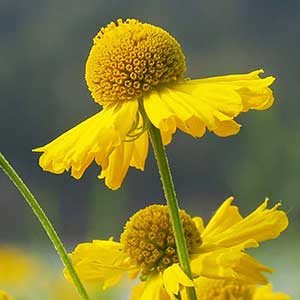Helenium autumnale
Helenium virginicum
common sneezeweed, fall sneezeweed, hélénie automnale, large-flower sneezeweed, mountain sneezeweed
Virginia sneezeweed
1(–7), branched distally, strongly winged, sparsely to densely hairy proximally, moderately to densely hairy distally.
1(–2), branched distally, strongly winged, glabrous or sparsely to moderately hairy proximally, glabrous or sparsely hairy distally.
usually moderately to densely hairy, sometimes glabrous;
basal blades (withered by flowering) lanceolate, oblanceolate, or obovate, entire or weakly lobed;
proximal and mid blades obovate to oblanceolate, usually dentate or entire;
distal blades oblanceolate to lanceolate, entire or dentate.
glabrous or sparsely to densely hairy;
basal blades oblanceolate, weakly to strongly lobed;
proximal and mid blades oblanceolate to lanceolate, usually entire, sometimes dentate;
distal blades usually lanceolate, entire.
3–10 cm, moderately to densely hairy.
2–8 cm, sparsely to moderately hairy.
globoid, 8–20 × 8–23 mm.
globoid, 8–15 × 10–16 mm.
8–21, pistillate, fertile;
corollas yellow, 10–23 × 4–10 mm.
8–13, pistillate, fertile;
corollas yellow, 10–15 × 4–10 mm.
200–400(–800+);
corollas yellow proximally, yellow to yellow-brown distally, 2.4–4 mm, lobes 5.
200–400+;
corollas yellow proximally, yellow to yellow-brown distally, 2.5–3.5 mm, lobes 5.
(connate proximally) moderately to densely hairy.
(connate proximally) sparsely to moderately hairy.
5–70(–100+) per plant, in paniculiform arrays.
2–25+ per plant, in paniculiform arrays.
1–2 mm, sparsely to moderately hairy;
pappi of 5–7 entire, aristate scales (0.5–)0.9–1.5(–1.8) mm.
1.8–2.3 mm, moderately hairy;
pappi of 5–6 entire, aristate scales 1.3–2 mm.
= 32, 34, 36.
Helenium autumnale
Helenium virginicum
Of conservation concern.
M. C. Simurda and J. S. Knox (2000) presented ITS sequence data that placed a population of Helenium virginicum from the Ozark highlands of southern Missouri in a monophyletic group with six populations of H. virginicum from the Shenandoah Valley of Virginia. R. L. Rimer and J. W. Summers (Missouri Department of Conservation, pers. comm.) located 42 H. virginicum populations in six counties in the Ozark highlands of Missouri. G. A. Yatskievych (Missouri Botanical Garden, pers. comm. to editors) has stated, “. . . the existence of this taxon in Missouri is no longer a matter of a single odd population, but probably rather another case of a taxon with two disjunct centers following dissection of a range during the Pleistocene glaciation.”
Helenium virginicum is in the Center for Plant Conservation’s National Collection of Endangered Plants.
(Discussion copyrighted by Flora of North America; reprinted with permission.)
- Local floras:
BC,
CA,
OR,
WA
- Local Web sites:
CalFlora,
CalPhotos,
Flora NW,
Go Botany,
IL Wildflowers,
KS Wildflowers,
LA Plants,
MD Biodiversity,
MI Flora,
MO Plants,
PNW Herbaria,
Turner Photog.
WildflowerSearch
iNaturalist (observations)
USDA Plants Database
- LBJ Wildflower Center
- SEINet
- Plants of the World Online
- Encyclopedia of Life
- Wikipedia
- Google Image Search


